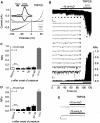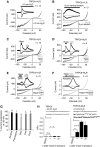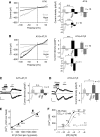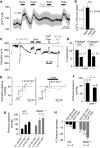Gq-coupled receptors as mechanosensors mediating myogenic vasoconstriction
- PMID: 18987636
- PMCID: PMC2599876
- DOI: 10.1038/emboj.2008.233
Gq-coupled receptors as mechanosensors mediating myogenic vasoconstriction
Abstract
Despite the central physiological function of the myogenic response, the underlying signalling pathways and the identity of mechanosensors in vascular smooth muscle (VSM) are still elusive. In contrast to present thinking, we show that membrane stretch does not primarily gate mechanosensitive transient receptor potential (TRP) ion channels, but leads to agonist-independent activation of G(q/11)-coupled receptors, which subsequently signal to TRPC channels in a G protein- and phospholipase C-dependent manner. Mechanically activated receptors adopt an active conformation, allowing for productive G protein coupling and recruitment of beta-arrestin. Agonist-independent receptor activation by mechanical stimuli is blocked by specific antagonists and inverse agonists. Increasing the AT(1) angiotensin II receptor density in mechanically unresponsive rat aortic A7r5 cells resulted in mechanosensitivity. Myogenic tone of cerebral and renal arteries is profoundly diminished by the inverse angiotensin II AT(1) receptor agonist losartan independently of angiotensin II (AII) secretion. This inhibitory effect is enhanced in blood vessels of mice deficient in the regulator of G-protein signalling-2. These findings suggest that G(q/11)-coupled receptors function as sensors of membrane stretch in VSM cells.
Figures







Comment in
-
TRPCs, GPCRs and the Bayliss effect.EMBO J. 2009 Jan 7;28(1):4-5. doi: 10.1038/emboj.2008.261. EMBO J. 2009. PMID: 19129760 Free PMC article. No abstract available.
References
-
- Ben-Chaim Y, Chanda B, Dascal N, Bezanilla F, Parnas I, Parnas H (2006) Movement of ‘gating charge' is coupled to ligand binding in a G-protein-coupled receptor. Nature 444: 106–109 - PubMed
-
- Charest PG, Bouvier M (2003) Palmitoylation of the V2 vasopressin receptor carboxyl tail enhances beta-arrestin recruitment leading to efficient receptor endocytosis and ERK1/2 activation. J Biol Chem 278: 41541–41551 - PubMed
-
- Clapham DE (2003) TRP channels as cellular sensors. Nature 426: 517–524 - PubMed
-
- Davis MJ, Hill MA (1999) Signaling mechanisms underlying the vascular myogenic response. Physiol Rev 79: 387–423 - PubMed
Publication types
MeSH terms
Substances
LinkOut - more resources
Full Text Sources
Other Literature Sources
Molecular Biology Databases
Research Materials

